Case Study: Genentech's Business Strategy and Roche Merger Analysis
VerifiedAdded on 2021/10/07
|11
|3021
|105
Case Study
AI Summary
This case study analyzes Genentech, a biotechnology company, and its strategic partnership with Roche. The study examines Genentech's resources, capabilities, and competencies, including its expertise in biotherapeutics and market dominance in oncology. It explores Genentech's business strategies, such as product diversification into neuroscience and infectious diseases to mitigate risks associated with government regulations on cancer products. The analysis delves into the impact of the Avastin clinical trial failure and the subsequent Roche merger, highlighting changes in management and operational structures. The case also covers Genentech's marketing efforts, ethical considerations in product development, and the company's financial performance, including revenue and market share. The study emphasizes the importance of factors such as medical need, market opportunity, and scientific rationale in Genentech's product development process, as well as the ethical considerations in drug testing and clinical trials.
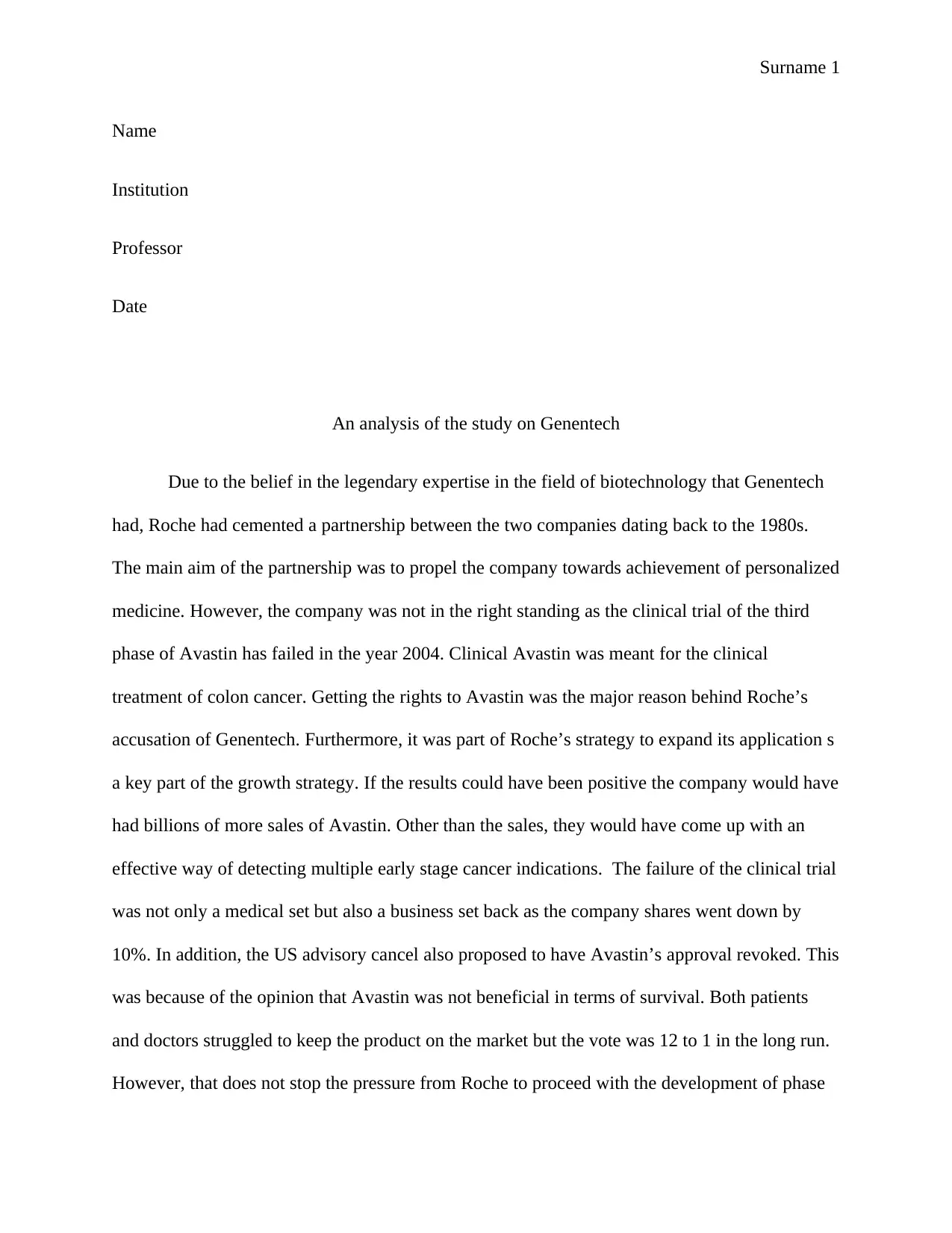
Surname 1
Name
Institution
Professor
Date
An analysis of the study on Genentech
Due to the belief in the legendary expertise in the field of biotechnology that Genentech
had, Roche had cemented a partnership between the two companies dating back to the 1980s.
The main aim of the partnership was to propel the company towards achievement of personalized
medicine. However, the company was not in the right standing as the clinical trial of the third
phase of Avastin has failed in the year 2004. Clinical Avastin was meant for the clinical
treatment of colon cancer. Getting the rights to Avastin was the major reason behind Roche’s
accusation of Genentech. Furthermore, it was part of Roche’s strategy to expand its application s
a key part of the growth strategy. If the results could have been positive the company would have
had billions of more sales of Avastin. Other than the sales, they would have come up with an
effective way of detecting multiple early stage cancer indications. The failure of the clinical trial
was not only a medical set but also a business set back as the company shares went down by
10%. In addition, the US advisory cancel also proposed to have Avastin’s approval revoked. This
was because of the opinion that Avastin was not beneficial in terms of survival. Both patients
and doctors struggled to keep the product on the market but the vote was 12 to 1 in the long run.
However, that does not stop the pressure from Roche to proceed with the development of phase
Name
Institution
Professor
Date
An analysis of the study on Genentech
Due to the belief in the legendary expertise in the field of biotechnology that Genentech
had, Roche had cemented a partnership between the two companies dating back to the 1980s.
The main aim of the partnership was to propel the company towards achievement of personalized
medicine. However, the company was not in the right standing as the clinical trial of the third
phase of Avastin has failed in the year 2004. Clinical Avastin was meant for the clinical
treatment of colon cancer. Getting the rights to Avastin was the major reason behind Roche’s
accusation of Genentech. Furthermore, it was part of Roche’s strategy to expand its application s
a key part of the growth strategy. If the results could have been positive the company would have
had billions of more sales of Avastin. Other than the sales, they would have come up with an
effective way of detecting multiple early stage cancer indications. The failure of the clinical trial
was not only a medical set but also a business set back as the company shares went down by
10%. In addition, the US advisory cancel also proposed to have Avastin’s approval revoked. This
was because of the opinion that Avastin was not beneficial in terms of survival. Both patients
and doctors struggled to keep the product on the market but the vote was 12 to 1 in the long run.
However, that does not stop the pressure from Roche to proceed with the development of phase
Paraphrase This Document
Need a fresh take? Get an instant paraphrase of this document with our AI Paraphraser
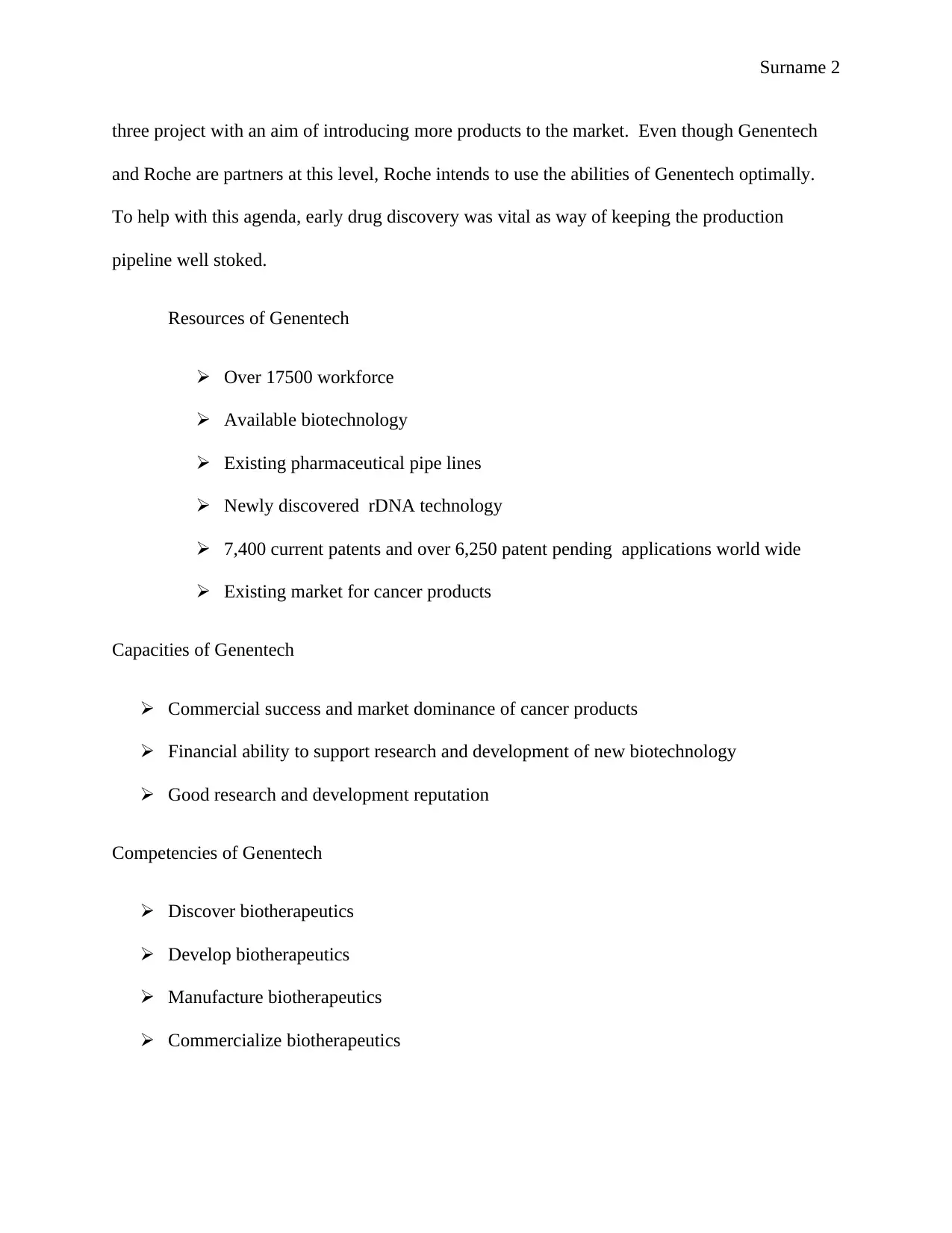
Surname 2
three project with an aim of introducing more products to the market. Even though Genentech
and Roche are partners at this level, Roche intends to use the abilities of Genentech optimally.
To help with this agenda, early drug discovery was vital as way of keeping the production
pipeline well stoked.
Resources of Genentech
Over 17500 workforce
Available biotechnology
Existing pharmaceutical pipe lines
Newly discovered rDNA technology
7,400 current patents and over 6,250 patent pending applications world wide
Existing market for cancer products
Capacities of Genentech
Commercial success and market dominance of cancer products
Financial ability to support research and development of new biotechnology
Good research and development reputation
Competencies of Genentech
Discover biotherapeutics
Develop biotherapeutics
Manufacture biotherapeutics
Commercialize biotherapeutics
three project with an aim of introducing more products to the market. Even though Genentech
and Roche are partners at this level, Roche intends to use the abilities of Genentech optimally.
To help with this agenda, early drug discovery was vital as way of keeping the production
pipeline well stoked.
Resources of Genentech
Over 17500 workforce
Available biotechnology
Existing pharmaceutical pipe lines
Newly discovered rDNA technology
7,400 current patents and over 6,250 patent pending applications world wide
Existing market for cancer products
Capacities of Genentech
Commercial success and market dominance of cancer products
Financial ability to support research and development of new biotechnology
Good research and development reputation
Competencies of Genentech
Discover biotherapeutics
Develop biotherapeutics
Manufacture biotherapeutics
Commercialize biotherapeutics
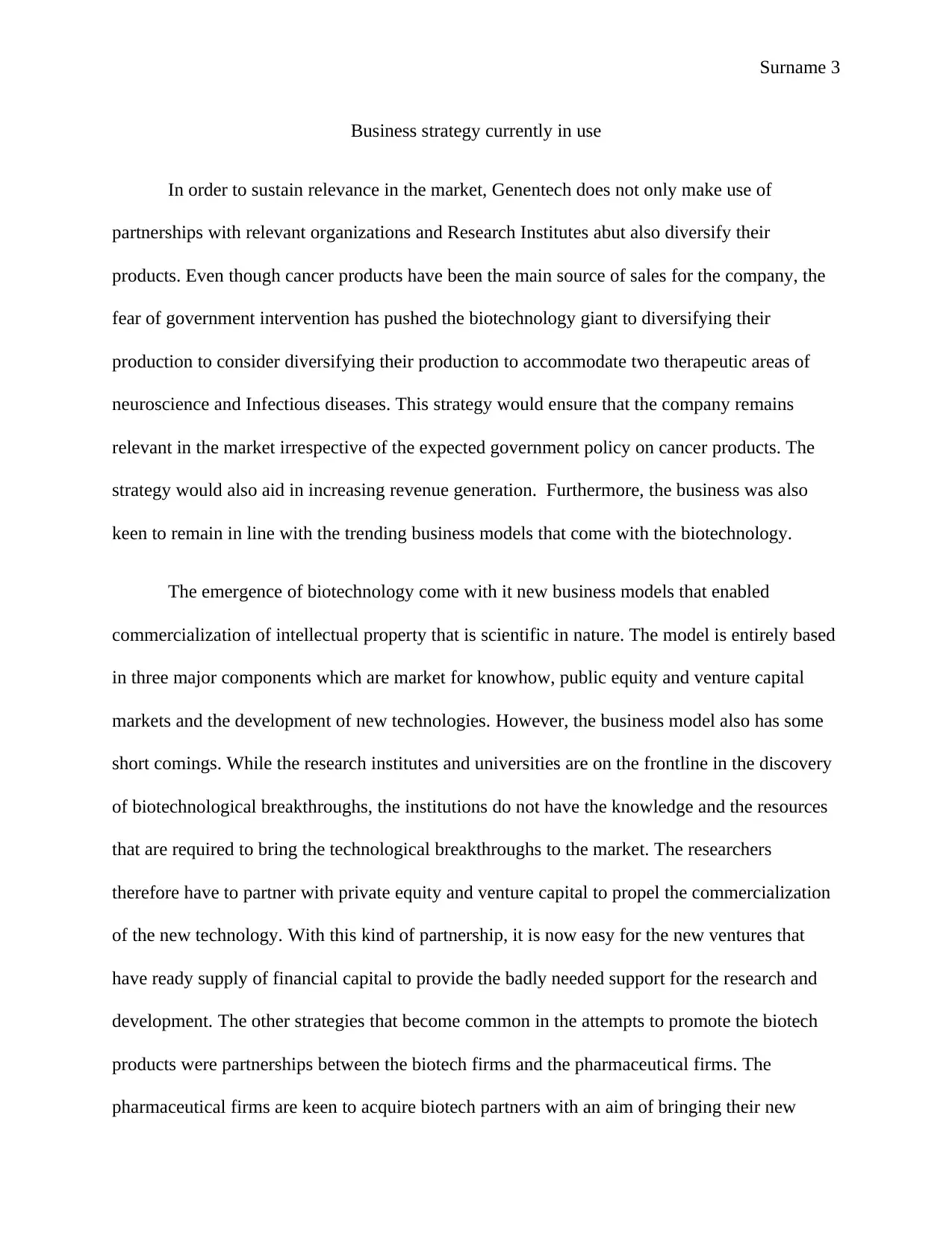
Surname 3
Business strategy currently in use
In order to sustain relevance in the market, Genentech does not only make use of
partnerships with relevant organizations and Research Institutes abut also diversify their
products. Even though cancer products have been the main source of sales for the company, the
fear of government intervention has pushed the biotechnology giant to diversifying their
production to consider diversifying their production to accommodate two therapeutic areas of
neuroscience and Infectious diseases. This strategy would ensure that the company remains
relevant in the market irrespective of the expected government policy on cancer products. The
strategy would also aid in increasing revenue generation. Furthermore, the business was also
keen to remain in line with the trending business models that come with the biotechnology.
The emergence of biotechnology come with it new business models that enabled
commercialization of intellectual property that is scientific in nature. The model is entirely based
in three major components which are market for knowhow, public equity and venture capital
markets and the development of new technologies. However, the business model also has some
short comings. While the research institutes and universities are on the frontline in the discovery
of biotechnological breakthroughs, the institutions do not have the knowledge and the resources
that are required to bring the technological breakthroughs to the market. The researchers
therefore have to partner with private equity and venture capital to propel the commercialization
of the new technology. With this kind of partnership, it is now easy for the new ventures that
have ready supply of financial capital to provide the badly needed support for the research and
development. The other strategies that become common in the attempts to promote the biotech
products were partnerships between the biotech firms and the pharmaceutical firms. The
pharmaceutical firms are keen to acquire biotech partners with an aim of bringing their new
Business strategy currently in use
In order to sustain relevance in the market, Genentech does not only make use of
partnerships with relevant organizations and Research Institutes abut also diversify their
products. Even though cancer products have been the main source of sales for the company, the
fear of government intervention has pushed the biotechnology giant to diversifying their
production to consider diversifying their production to accommodate two therapeutic areas of
neuroscience and Infectious diseases. This strategy would ensure that the company remains
relevant in the market irrespective of the expected government policy on cancer products. The
strategy would also aid in increasing revenue generation. Furthermore, the business was also
keen to remain in line with the trending business models that come with the biotechnology.
The emergence of biotechnology come with it new business models that enabled
commercialization of intellectual property that is scientific in nature. The model is entirely based
in three major components which are market for knowhow, public equity and venture capital
markets and the development of new technologies. However, the business model also has some
short comings. While the research institutes and universities are on the frontline in the discovery
of biotechnological breakthroughs, the institutions do not have the knowledge and the resources
that are required to bring the technological breakthroughs to the market. The researchers
therefore have to partner with private equity and venture capital to propel the commercialization
of the new technology. With this kind of partnership, it is now easy for the new ventures that
have ready supply of financial capital to provide the badly needed support for the research and
development. The other strategies that become common in the attempts to promote the biotech
products were partnerships between the biotech firms and the pharmaceutical firms. The
pharmaceutical firms are keen to acquire biotech partners with an aim of bringing their new
⊘ This is a preview!⊘
Do you want full access?
Subscribe today to unlock all pages.

Trusted by 1+ million students worldwide
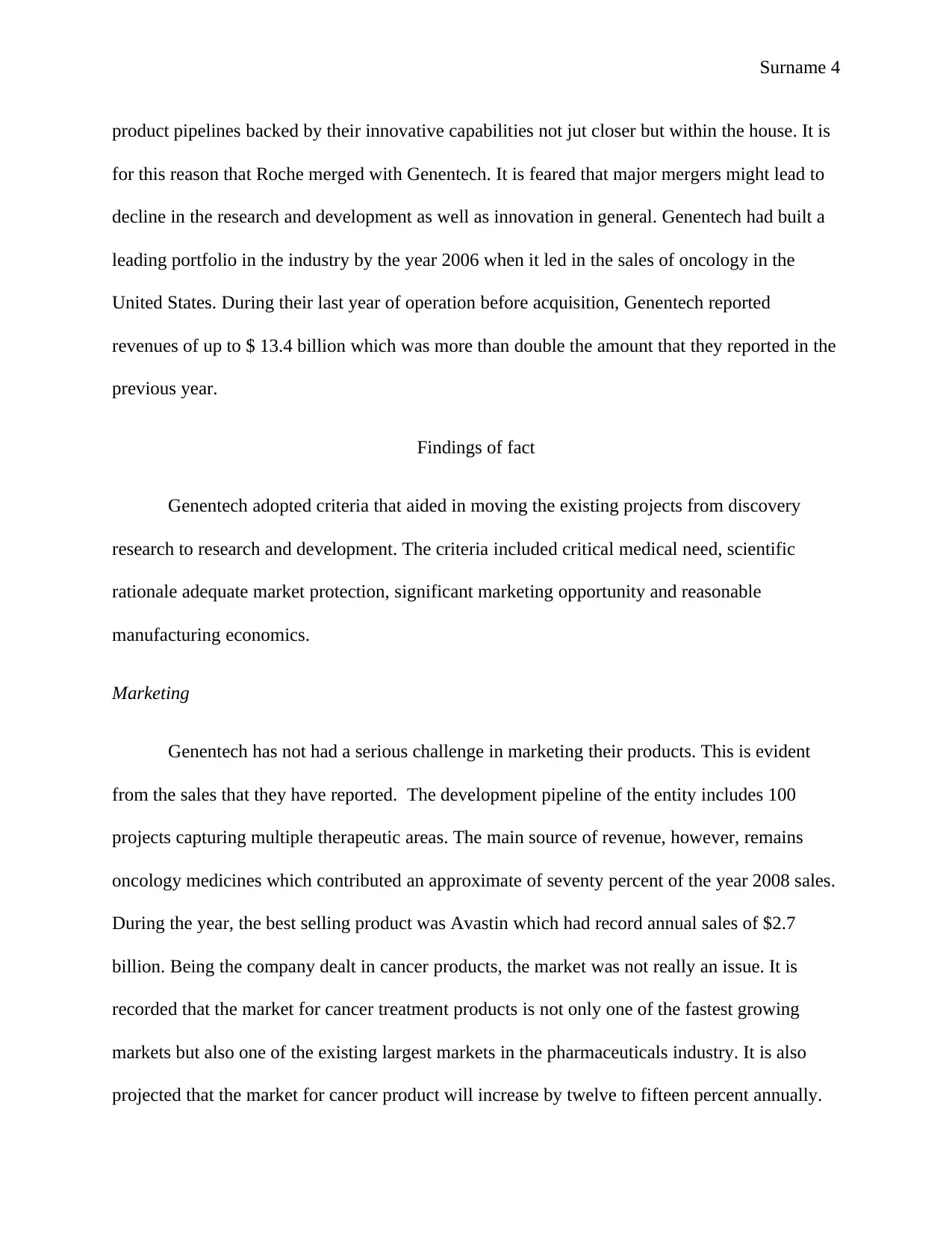
Surname 4
product pipelines backed by their innovative capabilities not jut closer but within the house. It is
for this reason that Roche merged with Genentech. It is feared that major mergers might lead to
decline in the research and development as well as innovation in general. Genentech had built a
leading portfolio in the industry by the year 2006 when it led in the sales of oncology in the
United States. During their last year of operation before acquisition, Genentech reported
revenues of up to $ 13.4 billion which was more than double the amount that they reported in the
previous year.
Findings of fact
Genentech adopted criteria that aided in moving the existing projects from discovery
research to research and development. The criteria included critical medical need, scientific
rationale adequate market protection, significant marketing opportunity and reasonable
manufacturing economics.
Marketing
Genentech has not had a serious challenge in marketing their products. This is evident
from the sales that they have reported. The development pipeline of the entity includes 100
projects capturing multiple therapeutic areas. The main source of revenue, however, remains
oncology medicines which contributed an approximate of seventy percent of the year 2008 sales.
During the year, the best selling product was Avastin which had record annual sales of $2.7
billion. Being the company dealt in cancer products, the market was not really an issue. It is
recorded that the market for cancer treatment products is not only one of the fastest growing
markets but also one of the existing largest markets in the pharmaceuticals industry. It is also
projected that the market for cancer product will increase by twelve to fifteen percent annually.
product pipelines backed by their innovative capabilities not jut closer but within the house. It is
for this reason that Roche merged with Genentech. It is feared that major mergers might lead to
decline in the research and development as well as innovation in general. Genentech had built a
leading portfolio in the industry by the year 2006 when it led in the sales of oncology in the
United States. During their last year of operation before acquisition, Genentech reported
revenues of up to $ 13.4 billion which was more than double the amount that they reported in the
previous year.
Findings of fact
Genentech adopted criteria that aided in moving the existing projects from discovery
research to research and development. The criteria included critical medical need, scientific
rationale adequate market protection, significant marketing opportunity and reasonable
manufacturing economics.
Marketing
Genentech has not had a serious challenge in marketing their products. This is evident
from the sales that they have reported. The development pipeline of the entity includes 100
projects capturing multiple therapeutic areas. The main source of revenue, however, remains
oncology medicines which contributed an approximate of seventy percent of the year 2008 sales.
During the year, the best selling product was Avastin which had record annual sales of $2.7
billion. Being the company dealt in cancer products, the market was not really an issue. It is
recorded that the market for cancer treatment products is not only one of the fastest growing
markets but also one of the existing largest markets in the pharmaceuticals industry. It is also
projected that the market for cancer product will increase by twelve to fifteen percent annually.
Paraphrase This Document
Need a fresh take? Get an instant paraphrase of this document with our AI Paraphraser
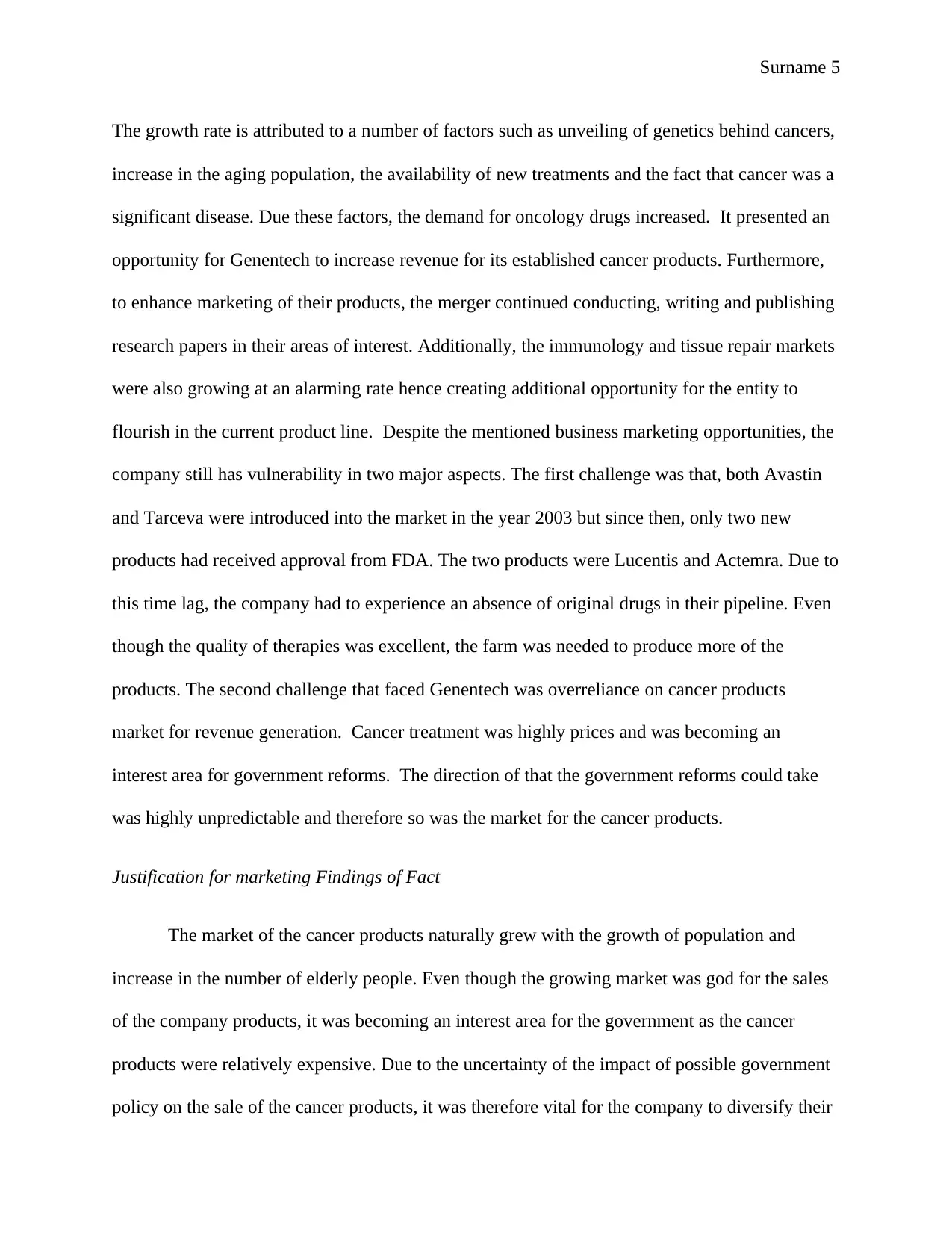
Surname 5
The growth rate is attributed to a number of factors such as unveiling of genetics behind cancers,
increase in the aging population, the availability of new treatments and the fact that cancer was a
significant disease. Due these factors, the demand for oncology drugs increased. It presented an
opportunity for Genentech to increase revenue for its established cancer products. Furthermore,
to enhance marketing of their products, the merger continued conducting, writing and publishing
research papers in their areas of interest. Additionally, the immunology and tissue repair markets
were also growing at an alarming rate hence creating additional opportunity for the entity to
flourish in the current product line. Despite the mentioned business marketing opportunities, the
company still has vulnerability in two major aspects. The first challenge was that, both Avastin
and Tarceva were introduced into the market in the year 2003 but since then, only two new
products had received approval from FDA. The two products were Lucentis and Actemra. Due to
this time lag, the company had to experience an absence of original drugs in their pipeline. Even
though the quality of therapies was excellent, the farm was needed to produce more of the
products. The second challenge that faced Genentech was overreliance on cancer products
market for revenue generation. Cancer treatment was highly prices and was becoming an
interest area for government reforms. The direction of that the government reforms could take
was highly unpredictable and therefore so was the market for the cancer products.
Justification for marketing Findings of Fact
The market of the cancer products naturally grew with the growth of population and
increase in the number of elderly people. Even though the growing market was god for the sales
of the company products, it was becoming an interest area for the government as the cancer
products were relatively expensive. Due to the uncertainty of the impact of possible government
policy on the sale of the cancer products, it was therefore vital for the company to diversify their
The growth rate is attributed to a number of factors such as unveiling of genetics behind cancers,
increase in the aging population, the availability of new treatments and the fact that cancer was a
significant disease. Due these factors, the demand for oncology drugs increased. It presented an
opportunity for Genentech to increase revenue for its established cancer products. Furthermore,
to enhance marketing of their products, the merger continued conducting, writing and publishing
research papers in their areas of interest. Additionally, the immunology and tissue repair markets
were also growing at an alarming rate hence creating additional opportunity for the entity to
flourish in the current product line. Despite the mentioned business marketing opportunities, the
company still has vulnerability in two major aspects. The first challenge was that, both Avastin
and Tarceva were introduced into the market in the year 2003 but since then, only two new
products had received approval from FDA. The two products were Lucentis and Actemra. Due to
this time lag, the company had to experience an absence of original drugs in their pipeline. Even
though the quality of therapies was excellent, the farm was needed to produce more of the
products. The second challenge that faced Genentech was overreliance on cancer products
market for revenue generation. Cancer treatment was highly prices and was becoming an
interest area for government reforms. The direction of that the government reforms could take
was highly unpredictable and therefore so was the market for the cancer products.
Justification for marketing Findings of Fact
The market of the cancer products naturally grew with the growth of population and
increase in the number of elderly people. Even though the growing market was god for the sales
of the company products, it was becoming an interest area for the government as the cancer
products were relatively expensive. Due to the uncertainty of the impact of possible government
policy on the sale of the cancer products, it was therefore vital for the company to diversify their
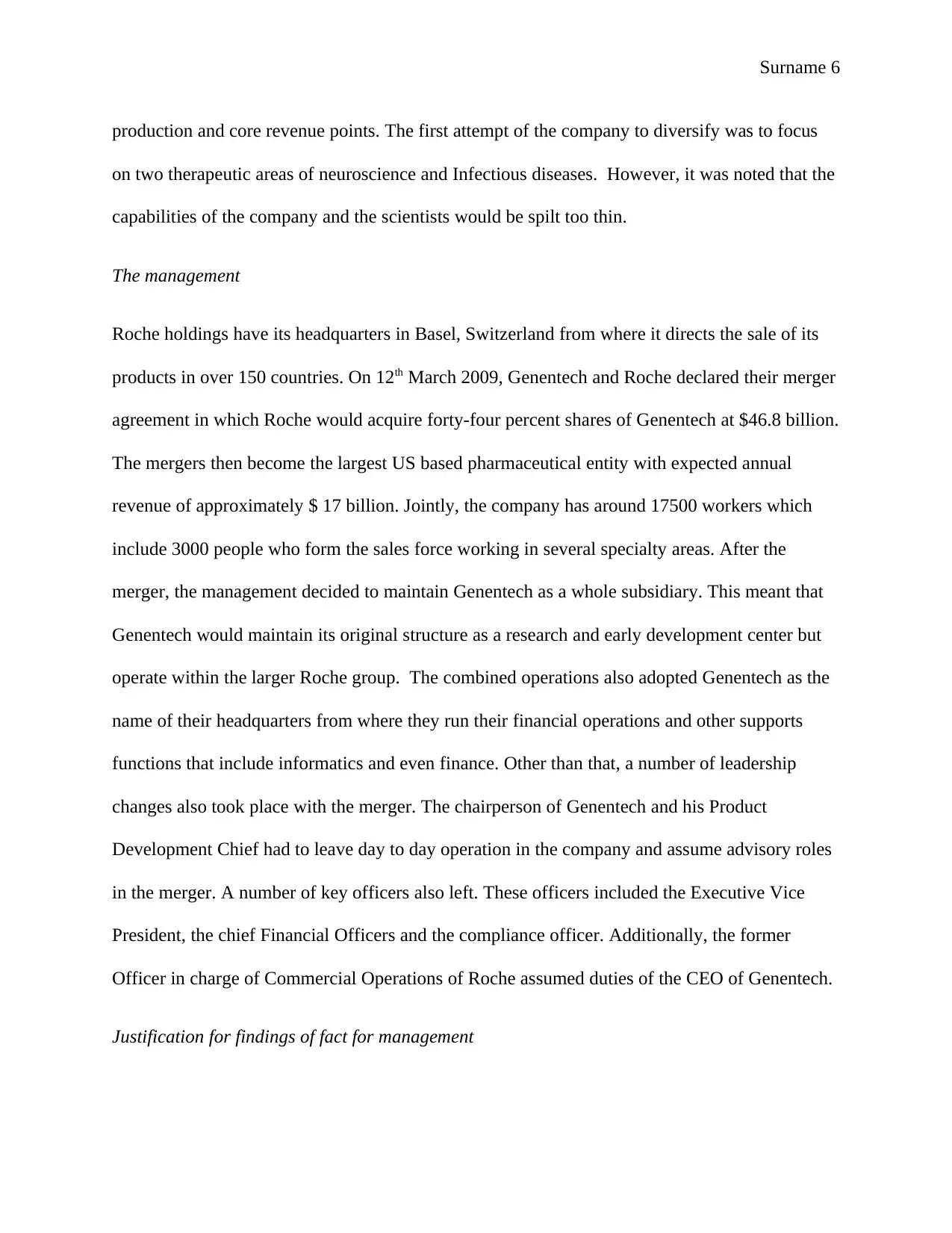
Surname 6
production and core revenue points. The first attempt of the company to diversify was to focus
on two therapeutic areas of neuroscience and Infectious diseases. However, it was noted that the
capabilities of the company and the scientists would be spilt too thin.
The management
Roche holdings have its headquarters in Basel, Switzerland from where it directs the sale of its
products in over 150 countries. On 12th March 2009, Genentech and Roche declared their merger
agreement in which Roche would acquire forty-four percent shares of Genentech at $46.8 billion.
The mergers then become the largest US based pharmaceutical entity with expected annual
revenue of approximately $ 17 billion. Jointly, the company has around 17500 workers which
include 3000 people who form the sales force working in several specialty areas. After the
merger, the management decided to maintain Genentech as a whole subsidiary. This meant that
Genentech would maintain its original structure as a research and early development center but
operate within the larger Roche group. The combined operations also adopted Genentech as the
name of their headquarters from where they run their financial operations and other supports
functions that include informatics and even finance. Other than that, a number of leadership
changes also took place with the merger. The chairperson of Genentech and his Product
Development Chief had to leave day to day operation in the company and assume advisory roles
in the merger. A number of key officers also left. These officers included the Executive Vice
President, the chief Financial Officers and the compliance officer. Additionally, the former
Officer in charge of Commercial Operations of Roche assumed duties of the CEO of Genentech.
Justification for findings of fact for management
production and core revenue points. The first attempt of the company to diversify was to focus
on two therapeutic areas of neuroscience and Infectious diseases. However, it was noted that the
capabilities of the company and the scientists would be spilt too thin.
The management
Roche holdings have its headquarters in Basel, Switzerland from where it directs the sale of its
products in over 150 countries. On 12th March 2009, Genentech and Roche declared their merger
agreement in which Roche would acquire forty-four percent shares of Genentech at $46.8 billion.
The mergers then become the largest US based pharmaceutical entity with expected annual
revenue of approximately $ 17 billion. Jointly, the company has around 17500 workers which
include 3000 people who form the sales force working in several specialty areas. After the
merger, the management decided to maintain Genentech as a whole subsidiary. This meant that
Genentech would maintain its original structure as a research and early development center but
operate within the larger Roche group. The combined operations also adopted Genentech as the
name of their headquarters from where they run their financial operations and other supports
functions that include informatics and even finance. Other than that, a number of leadership
changes also took place with the merger. The chairperson of Genentech and his Product
Development Chief had to leave day to day operation in the company and assume advisory roles
in the merger. A number of key officers also left. These officers included the Executive Vice
President, the chief Financial Officers and the compliance officer. Additionally, the former
Officer in charge of Commercial Operations of Roche assumed duties of the CEO of Genentech.
Justification for findings of fact for management
⊘ This is a preview!⊘
Do you want full access?
Subscribe today to unlock all pages.

Trusted by 1+ million students worldwide
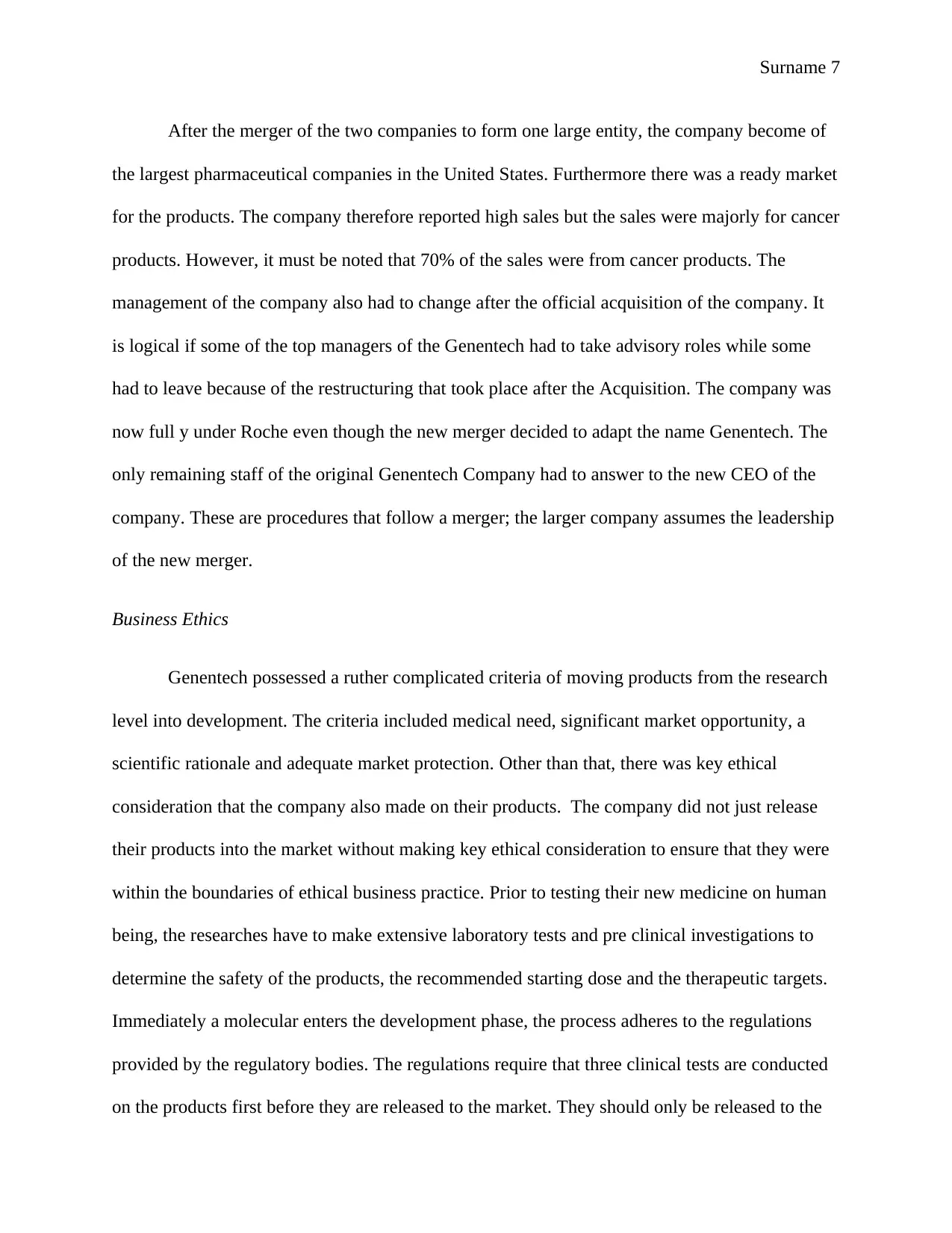
Surname 7
After the merger of the two companies to form one large entity, the company become of
the largest pharmaceutical companies in the United States. Furthermore there was a ready market
for the products. The company therefore reported high sales but the sales were majorly for cancer
products. However, it must be noted that 70% of the sales were from cancer products. The
management of the company also had to change after the official acquisition of the company. It
is logical if some of the top managers of the Genentech had to take advisory roles while some
had to leave because of the restructuring that took place after the Acquisition. The company was
now full y under Roche even though the new merger decided to adapt the name Genentech. The
only remaining staff of the original Genentech Company had to answer to the new CEO of the
company. These are procedures that follow a merger; the larger company assumes the leadership
of the new merger.
Business Ethics
Genentech possessed a ruther complicated criteria of moving products from the research
level into development. The criteria included medical need, significant market opportunity, a
scientific rationale and adequate market protection. Other than that, there was key ethical
consideration that the company also made on their products. The company did not just release
their products into the market without making key ethical consideration to ensure that they were
within the boundaries of ethical business practice. Prior to testing their new medicine on human
being, the researches have to make extensive laboratory tests and pre clinical investigations to
determine the safety of the products, the recommended starting dose and the therapeutic targets.
Immediately a molecular enters the development phase, the process adheres to the regulations
provided by the regulatory bodies. The regulations require that three clinical tests are conducted
on the products first before they are released to the market. They should only be released to the
After the merger of the two companies to form one large entity, the company become of
the largest pharmaceutical companies in the United States. Furthermore there was a ready market
for the products. The company therefore reported high sales but the sales were majorly for cancer
products. However, it must be noted that 70% of the sales were from cancer products. The
management of the company also had to change after the official acquisition of the company. It
is logical if some of the top managers of the Genentech had to take advisory roles while some
had to leave because of the restructuring that took place after the Acquisition. The company was
now full y under Roche even though the new merger decided to adapt the name Genentech. The
only remaining staff of the original Genentech Company had to answer to the new CEO of the
company. These are procedures that follow a merger; the larger company assumes the leadership
of the new merger.
Business Ethics
Genentech possessed a ruther complicated criteria of moving products from the research
level into development. The criteria included medical need, significant market opportunity, a
scientific rationale and adequate market protection. Other than that, there was key ethical
consideration that the company also made on their products. The company did not just release
their products into the market without making key ethical consideration to ensure that they were
within the boundaries of ethical business practice. Prior to testing their new medicine on human
being, the researches have to make extensive laboratory tests and pre clinical investigations to
determine the safety of the products, the recommended starting dose and the therapeutic targets.
Immediately a molecular enters the development phase, the process adheres to the regulations
provided by the regulatory bodies. The regulations require that three clinical tests are conducted
on the products first before they are released to the market. They should only be released to the
Paraphrase This Document
Need a fresh take? Get an instant paraphrase of this document with our AI Paraphraser
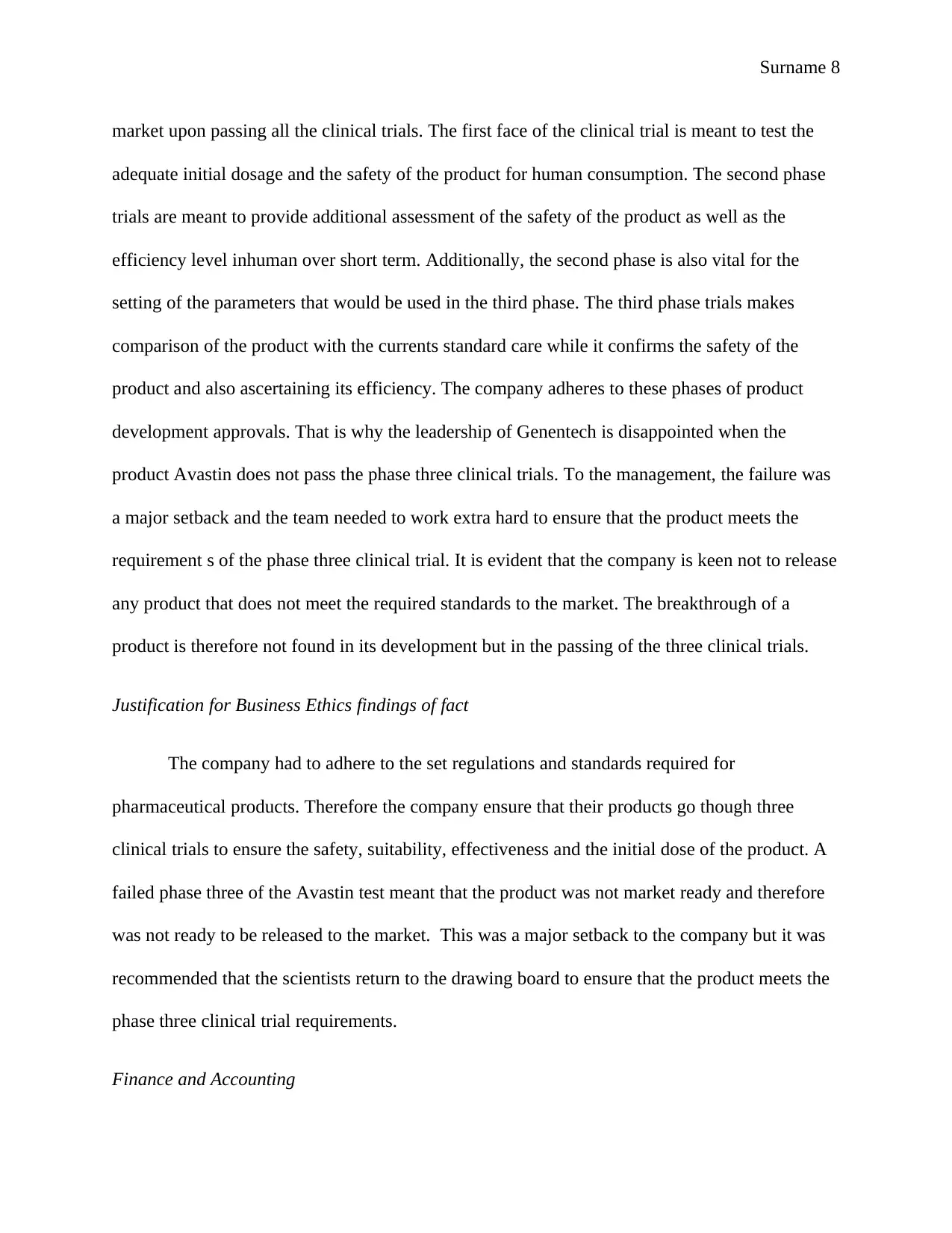
Surname 8
market upon passing all the clinical trials. The first face of the clinical trial is meant to test the
adequate initial dosage and the safety of the product for human consumption. The second phase
trials are meant to provide additional assessment of the safety of the product as well as the
efficiency level inhuman over short term. Additionally, the second phase is also vital for the
setting of the parameters that would be used in the third phase. The third phase trials makes
comparison of the product with the currents standard care while it confirms the safety of the
product and also ascertaining its efficiency. The company adheres to these phases of product
development approvals. That is why the leadership of Genentech is disappointed when the
product Avastin does not pass the phase three clinical trials. To the management, the failure was
a major setback and the team needed to work extra hard to ensure that the product meets the
requirement s of the phase three clinical trial. It is evident that the company is keen not to release
any product that does not meet the required standards to the market. The breakthrough of a
product is therefore not found in its development but in the passing of the three clinical trials.
Justification for Business Ethics findings of fact
The company had to adhere to the set regulations and standards required for
pharmaceutical products. Therefore the company ensure that their products go though three
clinical trials to ensure the safety, suitability, effectiveness and the initial dose of the product. A
failed phase three of the Avastin test meant that the product was not market ready and therefore
was not ready to be released to the market. This was a major setback to the company but it was
recommended that the scientists return to the drawing board to ensure that the product meets the
phase three clinical trial requirements.
Finance and Accounting
market upon passing all the clinical trials. The first face of the clinical trial is meant to test the
adequate initial dosage and the safety of the product for human consumption. The second phase
trials are meant to provide additional assessment of the safety of the product as well as the
efficiency level inhuman over short term. Additionally, the second phase is also vital for the
setting of the parameters that would be used in the third phase. The third phase trials makes
comparison of the product with the currents standard care while it confirms the safety of the
product and also ascertaining its efficiency. The company adheres to these phases of product
development approvals. That is why the leadership of Genentech is disappointed when the
product Avastin does not pass the phase three clinical trials. To the management, the failure was
a major setback and the team needed to work extra hard to ensure that the product meets the
requirement s of the phase three clinical trial. It is evident that the company is keen not to release
any product that does not meet the required standards to the market. The breakthrough of a
product is therefore not found in its development but in the passing of the three clinical trials.
Justification for Business Ethics findings of fact
The company had to adhere to the set regulations and standards required for
pharmaceutical products. Therefore the company ensure that their products go though three
clinical trials to ensure the safety, suitability, effectiveness and the initial dose of the product. A
failed phase three of the Avastin test meant that the product was not market ready and therefore
was not ready to be released to the market. This was a major setback to the company but it was
recommended that the scientists return to the drawing board to ensure that the product meets the
phase three clinical trial requirements.
Finance and Accounting
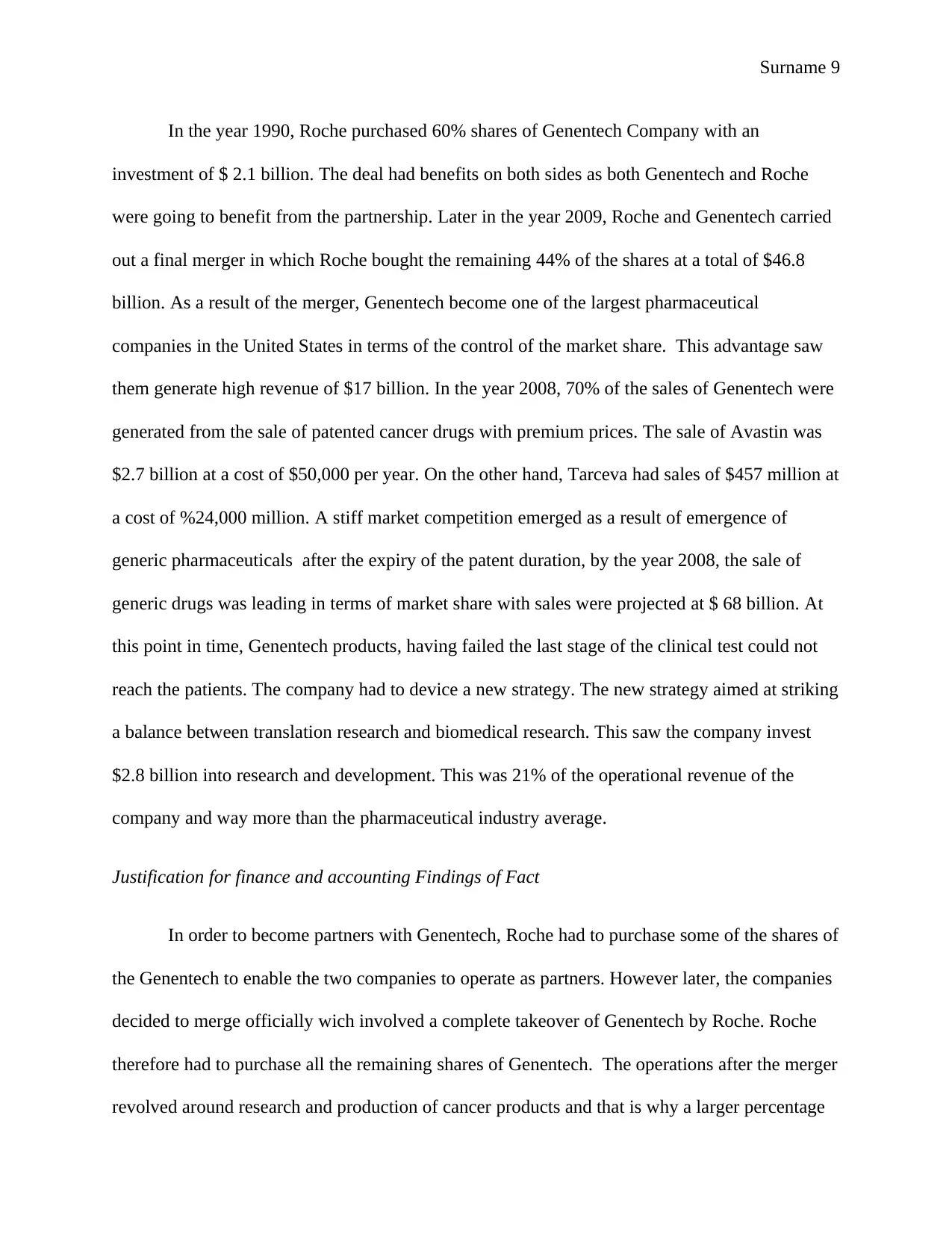
Surname 9
In the year 1990, Roche purchased 60% shares of Genentech Company with an
investment of $ 2.1 billion. The deal had benefits on both sides as both Genentech and Roche
were going to benefit from the partnership. Later in the year 2009, Roche and Genentech carried
out a final merger in which Roche bought the remaining 44% of the shares at a total of $46.8
billion. As a result of the merger, Genentech become one of the largest pharmaceutical
companies in the United States in terms of the control of the market share. This advantage saw
them generate high revenue of $17 billion. In the year 2008, 70% of the sales of Genentech were
generated from the sale of patented cancer drugs with premium prices. The sale of Avastin was
$2.7 billion at a cost of $50,000 per year. On the other hand, Tarceva had sales of $457 million at
a cost of %24,000 million. A stiff market competition emerged as a result of emergence of
generic pharmaceuticals after the expiry of the patent duration, by the year 2008, the sale of
generic drugs was leading in terms of market share with sales were projected at $ 68 billion. At
this point in time, Genentech products, having failed the last stage of the clinical test could not
reach the patients. The company had to device a new strategy. The new strategy aimed at striking
a balance between translation research and biomedical research. This saw the company invest
$2.8 billion into research and development. This was 21% of the operational revenue of the
company and way more than the pharmaceutical industry average.
Justification for finance and accounting Findings of Fact
In order to become partners with Genentech, Roche had to purchase some of the shares of
the Genentech to enable the two companies to operate as partners. However later, the companies
decided to merge officially wich involved a complete takeover of Genentech by Roche. Roche
therefore had to purchase all the remaining shares of Genentech. The operations after the merger
revolved around research and production of cancer products and that is why a larger percentage
In the year 1990, Roche purchased 60% shares of Genentech Company with an
investment of $ 2.1 billion. The deal had benefits on both sides as both Genentech and Roche
were going to benefit from the partnership. Later in the year 2009, Roche and Genentech carried
out a final merger in which Roche bought the remaining 44% of the shares at a total of $46.8
billion. As a result of the merger, Genentech become one of the largest pharmaceutical
companies in the United States in terms of the control of the market share. This advantage saw
them generate high revenue of $17 billion. In the year 2008, 70% of the sales of Genentech were
generated from the sale of patented cancer drugs with premium prices. The sale of Avastin was
$2.7 billion at a cost of $50,000 per year. On the other hand, Tarceva had sales of $457 million at
a cost of %24,000 million. A stiff market competition emerged as a result of emergence of
generic pharmaceuticals after the expiry of the patent duration, by the year 2008, the sale of
generic drugs was leading in terms of market share with sales were projected at $ 68 billion. At
this point in time, Genentech products, having failed the last stage of the clinical test could not
reach the patients. The company had to device a new strategy. The new strategy aimed at striking
a balance between translation research and biomedical research. This saw the company invest
$2.8 billion into research and development. This was 21% of the operational revenue of the
company and way more than the pharmaceutical industry average.
Justification for finance and accounting Findings of Fact
In order to become partners with Genentech, Roche had to purchase some of the shares of
the Genentech to enable the two companies to operate as partners. However later, the companies
decided to merge officially wich involved a complete takeover of Genentech by Roche. Roche
therefore had to purchase all the remaining shares of Genentech. The operations after the merger
revolved around research and production of cancer products and that is why a larger percentage
⊘ This is a preview!⊘
Do you want full access?
Subscribe today to unlock all pages.

Trusted by 1+ million students worldwide
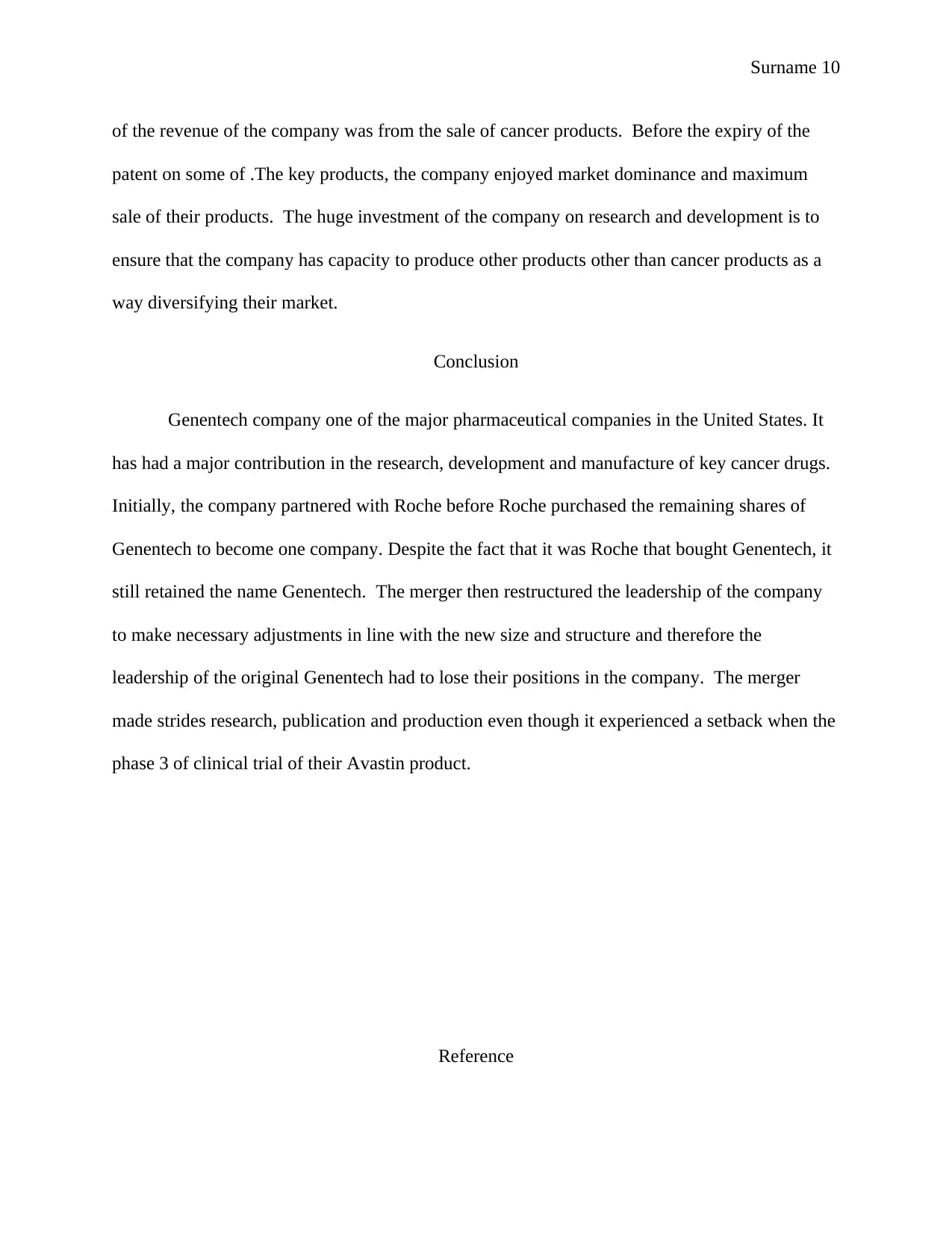
Surname 10
of the revenue of the company was from the sale of cancer products. Before the expiry of the
patent on some of .The key products, the company enjoyed market dominance and maximum
sale of their products. The huge investment of the company on research and development is to
ensure that the company has capacity to produce other products other than cancer products as a
way diversifying their market.
Conclusion
Genentech company one of the major pharmaceutical companies in the United States. It
has had a major contribution in the research, development and manufacture of key cancer drugs.
Initially, the company partnered with Roche before Roche purchased the remaining shares of
Genentech to become one company. Despite the fact that it was Roche that bought Genentech, it
still retained the name Genentech. The merger then restructured the leadership of the company
to make necessary adjustments in line with the new size and structure and therefore the
leadership of the original Genentech had to lose their positions in the company. The merger
made strides research, publication and production even though it experienced a setback when the
phase 3 of clinical trial of their Avastin product.
Reference
of the revenue of the company was from the sale of cancer products. Before the expiry of the
patent on some of .The key products, the company enjoyed market dominance and maximum
sale of their products. The huge investment of the company on research and development is to
ensure that the company has capacity to produce other products other than cancer products as a
way diversifying their market.
Conclusion
Genentech company one of the major pharmaceutical companies in the United States. It
has had a major contribution in the research, development and manufacture of key cancer drugs.
Initially, the company partnered with Roche before Roche purchased the remaining shares of
Genentech to become one company. Despite the fact that it was Roche that bought Genentech, it
still retained the name Genentech. The merger then restructured the leadership of the company
to make necessary adjustments in line with the new size and structure and therefore the
leadership of the original Genentech had to lose their positions in the company. The merger
made strides research, publication and production even though it experienced a setback when the
phase 3 of clinical trial of their Avastin product.
Reference
Paraphrase This Document
Need a fresh take? Get an instant paraphrase of this document with our AI Paraphraser

Surname 11
Becker, “Roche’s Acquisition of Genentech.” Harvard Business School Cases, Feb. 2010, p.
1. EBSCOhost, search.ebscohost.com/login.aspx?
direct=true&db=buh&AN=57774507&site=ehost-live.
Becker, “Roche’s Acquisition of Genentech.” Harvard Business School Cases, Feb. 2010, p.
1. EBSCOhost, search.ebscohost.com/login.aspx?
direct=true&db=buh&AN=57774507&site=ehost-live.
1 out of 11
Your All-in-One AI-Powered Toolkit for Academic Success.
+13062052269
info@desklib.com
Available 24*7 on WhatsApp / Email
![[object Object]](/_next/static/media/star-bottom.7253800d.svg)
Unlock your academic potential
Copyright © 2020–2025 A2Z Services. All Rights Reserved. Developed and managed by ZUCOL.
